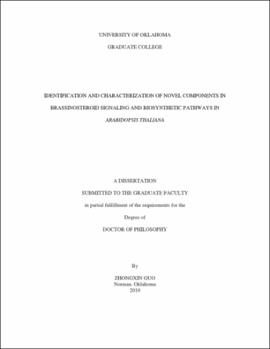Identification and characterization of novel components in brassinosteroid signaling and biosynthetic pathways in Arabidopsis thaliana
| dc.contributor.advisor | Li, Jia | |
| dc.creator | Guo, Zhongxin | |
| dc.date.accessioned | 2019-04-27T21:35:15Z | |
| dc.date.available | 2019-04-27T21:35:15Z | |
| dc.date.issued | 2010 | |
| dc.identifier | 99315480102042 | |
| dc.identifier.uri | https://hdl.handle.net/11244/319075 | |
| dc.description.abstract | Brassinosteroids (BRs) are steroidal hormones essential for normal plant growth and development. To dissect the essential role of BRs in plants, a gain-of-function approach, activation tagging, was used to identify components functioning in BR signaling and biosynthetic pathways in the model plant, Arabidopsis thaliana. In the dissertation research, two molecules were identified and characterized to be the novel regulators of the BR pathways. TCP1 was identified as a suppressor of a weak allele of BR receptor mutant. And TCP1 was identified as the first positive regulator of BR biosynthesis by regulating the expression of DWF4, a rate-limiting BR biosynthetic enzyme. CUR was identified as an enhancer of the weak allele of BR receptor mutant. CUR regulates leaf morphogenesis by controlling the expression of homeotic genes. CUR may connect the leaf development with BR signaling pathway in plant growth and development. | |
| dc.format.extent | 161 pages | |
| dc.format.medium | application.pdf | |
| dc.language | en_US | |
| dc.relation.requires | Adobe Acrobat Reader | |
| dc.subject | Brassinosteroids | |
| dc.subject | Arabidopsis thaliana | |
| dc.subject | Growth (Plants) | |
| dc.subject | Biosynthesis | |
| dc.title | Identification and characterization of novel components in brassinosteroid signaling and biosynthetic pathways in Arabidopsis thaliana | |
| dc.type | text | |
| dc.type | document | |
| dc.thesis.degree | Ph.D. | |
| ou.group | College of Arts and Sciences::Department of Microbiology and Plant Biology |
Files in this item
This item appears in the following Collection(s)
-
OU - Dissertations [9469]
